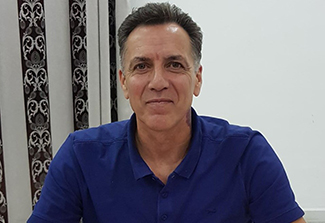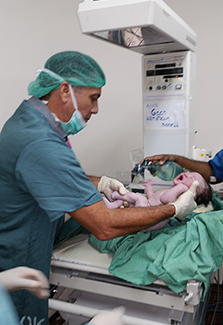Caring for kids (and their moms) in Suriname
March/April 2023 | Volume 22 Number 2
 Photo courtesy of Wilco ZijlmansDr. Wilco Zijlmans
Photo courtesy of Wilco ZijlmansDr. Wilco Zijlmans
Dr. Wilco Zijlmans, head of pediatrics and lecturer at Anton de Kom University of Suriname, also serves as an adjunct full professor at Tulane University School of Public Health and Tropical Medicine. Zijlmans trained in pediatrics at the Academic Medical Center in Amsterdam, the Netherlands, and works at the Diakonessen Hospital in Paramaribo, Suriname while also consulting for Primary Health Care Medical Mission Suriname. He is a member of the Global Child Health Group, a board member for the National Taskforce Tuberculosis/HIV, and a technical working group member of the Prevention of Mother-to-Child HIV Transmission, among other appointments. In 2015 he co-founded KidsClinic.
Why become a doctor and researcher?
I was born in the Netherlands and, when I was 2, my parents took me to Kenya in East Africa. At that time there was a TV series called “Daktari,” which means “doctor” in Swahili. It was about this doctor who’d get into his Land Rover with all his lab equipment, and he’d visit all the people in need in different villages. I think that's where my dreams started. When I was 13, my parents moved to Suriname, and I fell in love with the country instantly. I did my medical training, specialization and residency in pediatrics at the Academic Medical Center in Amsterdam, but as soon as I finished, I returned to Suriname in 1998—25 years ago now.
As a medical student, I worked in Ghana where I did research on schistosomiasis (also known as bilharzia). All the kids there suffered from the disease because it lives in the water. Since the villages lacked running water, all the kids had to get and carry water in buckets for their families, and so they would catch this disease. I also worked on the pediatric wards in Tanzania. During this period, I learned more than during my entire career because I had little else other than my two bare hands and my stethoscope—there’s no fancy tools to help you in rural villages. Research is a natural part of being a doctor, I believe. How else would we know if we’re on the right track without it? How can we improve treatments if we don’t do research?
What are the findings of your Fogarty project?
Our project looks at maternal exposures to heavy metals and pesticides in different regions of Suriname and the possible effects on pediatric neurodevelopment. We found marked differences among the regions. The women in the interior had elevated mercury and lead levels far above international thresholds and significantly higher than in other regions of the country. This is partly due to their consumption of fish that have been contaminated due to illegal gold mining activities, which use mercury for processing.
Surprisingly, the women also had a lot of lead in their blood. Our colleagues in neighboring French Guiana have seen the same and they believe there's a relationship to consumption of cassava and game (since lead bullets are used to shoot game). When we looked deeper, we saw significant developmental delays at age 1 among the children of mothers with elevated lead levels. The delays continued up to 32 months. We want to follow them as they get older so we’re pursuing different grants to continue this work.
One of our eight Ph.D. students also measured concentrations of protective elements, like selenium and fatty acids, in fish. Selenium can have protective effects, acting as a counter measure to mercury, as do fatty acids. She used questionnaires to understand what and how much fish the women consumed and, once we have that data, we might do tailor-made advice—try to eat this fish, not that fish—though of course their diet depends on what they catch and the other available food sources.
Can developmental delays be corrected?
If there's been brain-damage—which we don't know yet, we’d have to do MRIs and other tests—but if we detect damage at an early stage, then we can try to correct it. Brain development progresses very rapidly during a child’s first five years. At age 4, a child has developed 50% of its IQ already. So, the biggest effect you can have is in the first few years, whereas if you try to stimulate language and motor development once a child is an adolescent or older, it’s difficult. When researching, we don’t only record, we also intervene. For instance, when we would see a woman with a high concentration of mercury and lead, we first call her back to repeat the measurements and then we refer her to appropriate doctors. Everything comes down to nutrition and we need to start optimizing the health status of both expecting mothers and fathers
before conception. This is why I am hoping to continue this project.
 Photo courtesy of Wilco ZijlmansDr. Wilco Zijlmans studies maternal exposures to heavy metals and pesticides in different regions of Suriname which can lead to developmental delays.
Photo courtesy of Wilco ZijlmansDr. Wilco Zijlmans studies maternal exposures to heavy metals and pesticides in different regions of Suriname which can lead to developmental delays.
What does public health look like in Suriname?
The government’s Regional Health office has different stations along the coastal area, while Primary Health Care Medical Mission Suriname (which was founded by three churches but is funded by the government) has more than 50 facilities scattered through the interior. The medical mission, which serves the Amerindian and Maroon peoples, has a nice system of consultation, vaccination and school screenings. A lack of funding and, sometimes, a lack of organization can disrupt these systems. For example, ordering vaccines at the right time doesn’t always happen due to delayed payments, so there can be vaccine shortages.
Our Fogarty project created more awareness of the mercury problem and its impact on public health. Every year during our five-year project, we met with policymakers—the Minister of Health, community advisory boards, all relevant stakeholders—to communicate our findings to those who matter. It’s encouraging that Suriname has signed the Minamata Convention on Mercury, a worldwide treaty on diminishing the use of mercury. Other positives include the fact that Suriname is the greenest country in the world. Pristine tropical rainforest covers 93% of the country and, together with French Guiana, Guyana and the north of Brazil, we’re the “lungs” of earth. We are one of few carbon-negative countries on earth so we should keep it that way for both Suriname’s health and global health.
What's ahead for you?
We're pursuing grants to continue the work we’ve done with our field cohort, including funding from Fogarty, National Institute of Environmental Health Sciences (NIEHS), and interested organizations in the European Union. Currently, I'm also working with the medical mission and the psychiatry department of University of Groningen in the Netherlands on a project investigating mental health among indigenous people in Suriname. Their expression of stress and depression is different from ours and they possess protective qualities that we lack.
We are also working with the medical mission, using school screening data to look at anemia (low red blood cell counts) in children. Low iron levels, which cause anemia, impact neurological performance and achievement in school. The range of anemia is incredibly high both in pregnant women and in children from birth to 14. There’s a 60% rate of anemia among pregnant women, youngsters and school children in Suriname, higher than any other country in the region We’ve collected a complete dataset and plan to examine whether and how heavy metals influence levels of hemoglobin (the substance in red blood cells that carries oxygen). There's also an increased problem with flooding over the past five to 10 years, so we're planning on doing research in that area.
I also look forward to continuing KidsClinic, which I founded almost 8 years ago. It emphasizes preventive care for mothers and their children and delivers specialized pediatric care for chronically ill children. Perhaps you’ve heard about the first 1,000 days—the 9 months of pregnancy plus first two years of a child’s life? We promote awareness of the first 1,000 days and discuss nutrition during pregnancy and pre-conception because mothers and children need to be healthy during this important period of development.
How has Fogarty influenced your career?
It’s great to work with young, enthusiastic and promising global health researchers and future leaders in public health. They touch on topics that are relevant to Suriname and the region, so they motivate me and keep me sharp. Recently, I was invited to participate in the UJMT LAUNCH steering committee at Fogarty. The UJMT Consortium, a partnership among University of North Carolina-Chapel Hill, Johns Hopkins University, Morehouse School of Medicine, and Tulane University, supports mentored training in low- and middle-income countries for Fogarty's Launching Future Leaders in Global Health (LAUNCH) Research Training Program. I’m looking forward to contributing to make LAUNCH, which is built on the former Global Health Fellows and Scholars Program, even more successful.
More information
Updated April 6, 2023
To view Adobe PDF files,
download current, free accessible plug-ins from Adobe's website.
Related Fogarty Programs
Related World Regions / Countries
Related Global Health Research Topics